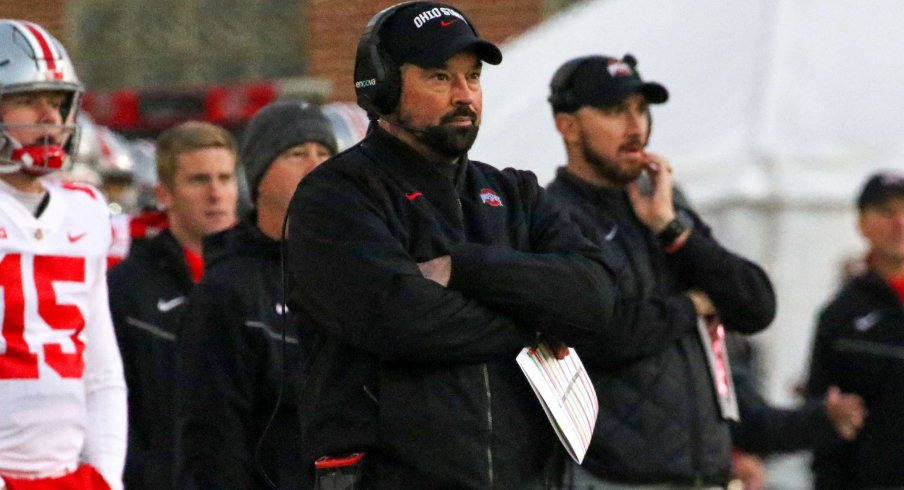Author's Note: In advance of Ohio State's matchup with Georgia in the Peach Bowl on December 31, Film Study will spend each week until then breaking down one aspect of the contest.
- December 8: Scouting the Georgia Defense
- Last Week: Scouting the Georgia Offense
- Today: Creating a Game Plan to beat Georgia
- Next Week: Ohio State's Keys to the Game
Offense
Attack the soft edge of the 'Mint' front
Some may think it a fool's errand for this Ohio State team to try and run the ball against the best rushing defense in the nation.
Yes, it is true that the Dawgs once again have built a championship contender on a foundation of stopping the run. It's also likely that no matter what the Buckeyes try to do against such a fear-inducing defensive front, they won't find much success picking up yards on the ground.
However, that doesn't mean they can or should abandon it altogether.
Despite all the relative struggles OSU has had when running the ball in short-yardage situations this fall, one might easily forget that this team has actually been one of the most efficient at doing so on early downs and between the 20s. Even against Michigan, the third-best run defense in America this season, the Buckeyes averaged nearly five yards per carry and tallied 143 total rush yards.
More interestingly, Michigan attempted to slow the run game by employing the odd 'Mint' front that Maryland employed quite often the week prior, which had flummoxed Ohio State early on. By the following week, however, Ryan Day, Kevin Wilson, and co. incorporated a number of answers into their play sheet which sealed the edge and created running lanes for Chip Trayanum and Miyan Williams.
Michigan in Mint, 2-high odd front. OSU goes to the Wisconsin game plan and attacks the soft edge. Should be more than 8 yards pic.twitter.com/YgVMdmAHuU
— Space Coyote (@SpaceCoyoteBDS) November 29, 2022
That Mint alignment, which places a defender directly over the center and on the inside shoulder of each offensive tackle, is Georgia's preferred look when trying to stop the run, meaning OSU should expect to see it early and often.
Relying on Paris Johnson Jr. and Dawand Jones, the two best offensive linemen all season in Scarlet and Gray, to seal those edges is a much safer bet than relying on the interior players to move All-everything D-lineman Jalen Carter out of the way.
Throw on Early Downs against Single-High Zones
Showing enough ability to run the ball on early downs will be critical, not because of the yards that will be gained by Buckeye running backs, but because of the looks the Bulldogs will employ to stop them. While it's not particularly novel for a defense to play single-high coverages on early downs to get an extra body in the box to stop the run, it's ingrained in this Georgia team's DNA.
Coordinator Will Muschamp is a single-safety die-hard who is most comfortable when employing such Cover 1 and Cover 3 looks the moment an opponent gains a rushing yard, and while that might make life harder for the OSU ground game, it will open up many opportunities through the air.
Such was the case the last time the University of Georgia lost a football game, which, coincidentally, was also in Mercedes-Benz Stadium. In the 2021 SEC championship game, Bryce Young threw for 421 yards and three touchdowns that afternoon as the Bulldogs failed to contain receivers John Metchie and Jameson Williams. All that success came despite Crimson Tide running backs being held to just 76 rushing yards on 22 carries.
While the Bulldogs were busy clogging the middle and stuffing the run, the Tide manipulated the Bulldog coverage by constantly lining up three receivers to the boundary and leaving Metchie or Williams alone to the field. This meant they had true single coverage with no safety help to the wide side, forcing the corners to play with a soft cushion and allowing for easy hitches and outs to be completed.
Such a tactic is a common one for this OSU team, with C.J. Stroud and Marvin Harrison Jr. hooking up on such patterns all season. But Alabama isn't the only team to find success throwing against these looks.
Just two weeks ago, LSU did the same by attacking the interior of the UGA defense when it employed this 3-deep zone-match coverage. The Tigers ran quite a few Snag and All-Curl concepts that stretched the underneath zones and put a great deal of pressure on the UGA linebackers.
Luckily, Stroud has proven capable of executing such concepts with ease as well.
Attack the Middle of the Field
When offenses start picking apart the Dawgs' single-high coverages, Muschamp will turn to the two-deep coverages that helped make his boss famous. But once again, teams with strong-armed quarterbacks and talented receivers have shown how to defeat such looks on multiple occasions.
In each of the past two SEC title games, Georgia's opponent has found repeated success by attacking the middle of the field, working the area in front of the safeties and behind the linebackers. On both occasions, the Bulldogs allowed long touchdowns to speedy receivers who found the soft spot over the middle before outrunning the UGA defense to the end zone.
Once again, such routes are not only common in the OSU playbook, but Day has assembled the personnel to execute them at a consistently high level.
Vertical stretches that create three levels of options for the QB and stress the inside hook defenders (often the inside linebackers) are the perfect antidote for the Bulldogs' preferred schemes.
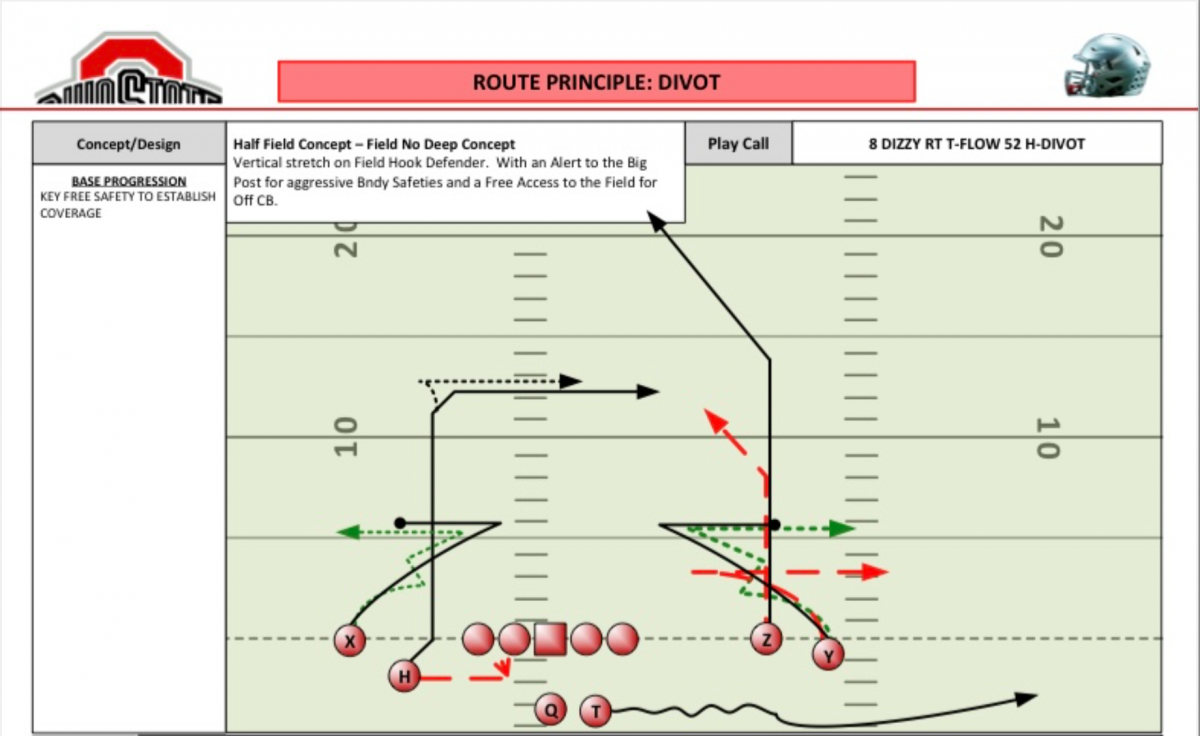
You can probably see Harrison Jr. running that pivot route to the boundary while Julian Fleming takes off downfield on a deep post, occupying the field safety and corner. Meanwhile, Emeka Egbuka is left to run a 12-yard dig route and outrun the boundary safety over the middle.
But just in case the Bulldogs get tricky and do a better job of disguising their coverages than they did against LSU, Stroud needs to have answers. Packaging a Cover 3 beater (such as Snag) to the field with a dig from the opposite side certainly feels like a good option.
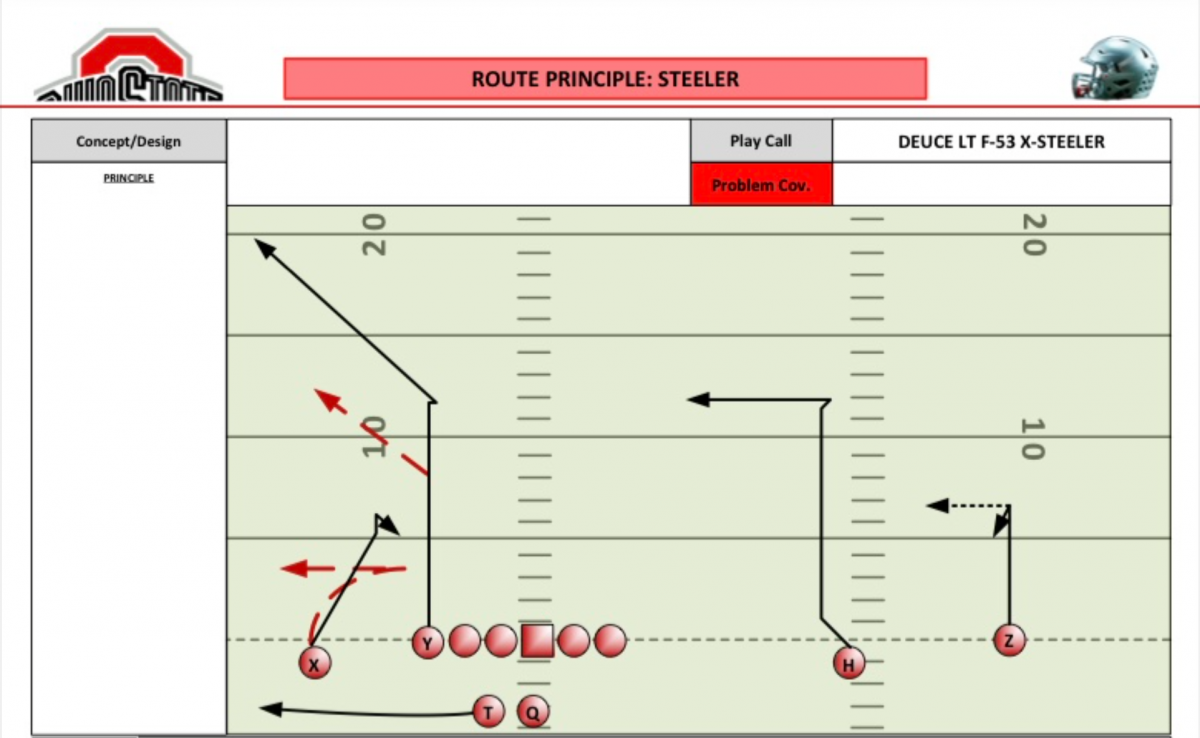
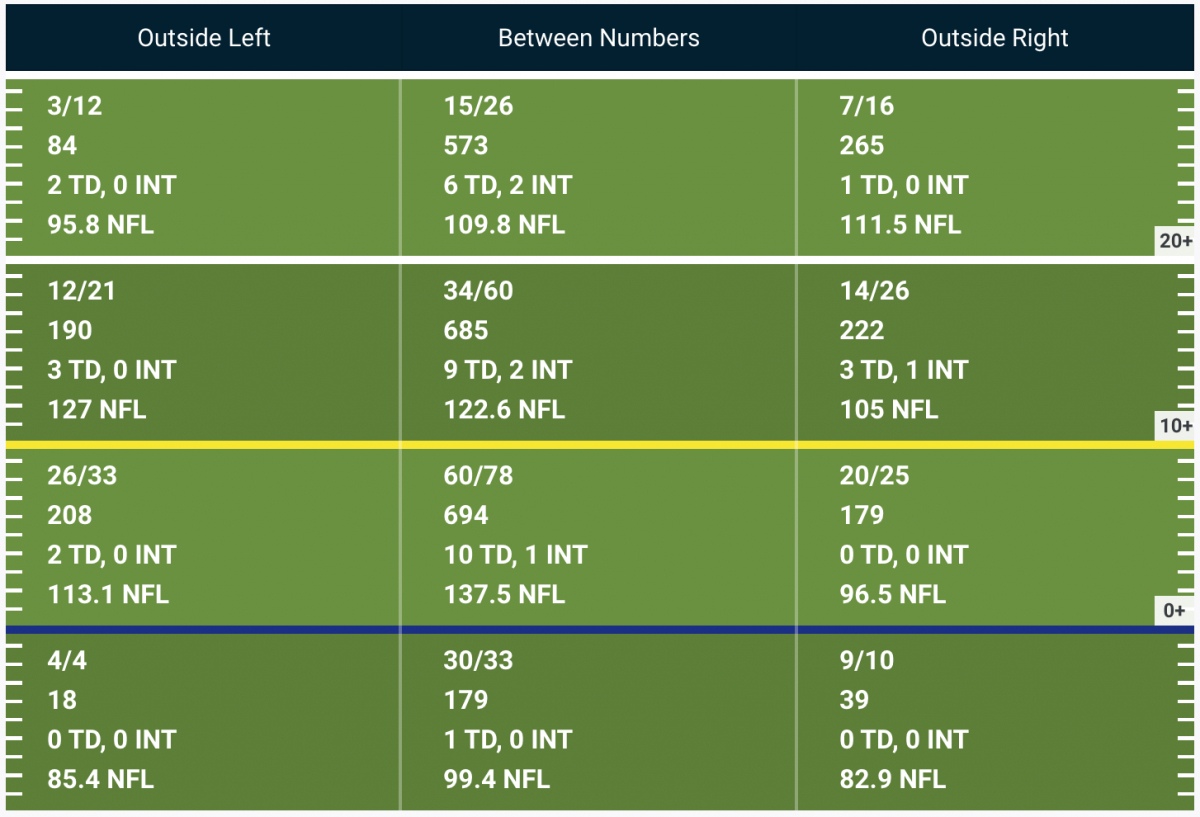
Many college coaches don't like to throw over the middle as it's usually the most crowded area on the field. But such is not the case with Day and Stroud. In fact, it's where the third-year QB is his most effective.
Not only does Stroud attempt the most passes in between the numbers, but his QB rating is also highest when throwing over the middle, as such throws allow his talented receivers to make plays after the catch.
Take Your Shots
Of course, if the Buckeyes not only want to keep the Bulldogs from getting too creative scheme-wise but to keep their safeties from biting up on those intermediate crossing routes, Stroud will have to attempt to take the top off of the defense.
Receivers from both LSU and Alabama beat UGA's best corner, Kelee Ringo on deep balls in the past two SEC title games, despite a Bulldog safety being in a position to help.
Simply put, the Bulldogs rarely face opponents with the arm strength possessed by Stroud or the talent at receiver. Tennessee may have been the exception, but the Volunteer offense is so fundamentally different on a schematic level that it is difficult to compare it to what Ohio state will bring to the table.
But for the OSU offense to be successful against this excellent UGA defense, it must show an ability to attack every level of the field. If the Buckeyes abandon the run, the Dawgs will simply drop eight players in coverage and take away the pass, and the inverse will happen if there is no threat of the deep ball.
If both threats are present, however, then the middle of the field should open up and allow the Buckeyes' best offensive weapons (its wide receivers) to attack the relative weakness of the Bulldog defense (its linebackers in pass coverage).
Defense
Keep playing inside-out against the run
While the narrative coming from Ohio State's most recent contest - the 45-23 loss to Michigan - was that of another beatdown at the hands of the maize and blue run game, the truth is more complicated. The system instilled by Jim Knowles has largely been a success in 2022.
Until the Buckeyes employed what was effectively a short-yardage defensive look in the final minutes of The Game, desperate to get a stop and selling out at the line of scrimmage, the Buckeyes had largely held the Michigan rushing attack in check, as they had with most opponents throughout the season.
One such reason for the change from a year ago is the manner in which Knowles' defense plugs the interior and forces ball carriers to the edge, rather than trying to pin them in between the tackles on every play as his predecessors had tried to do.
To accomplish this task, he doesn't simply line up big bodies in the A gaps. Instead, he calls for a variety of fronts, slants, stunts, and blitzes meant to blow up blocking schemes.
Employing a never-ending barrage of such tactics will be critical for Ohio State to get bodies in the middle and force Georgia backs to go horizontally instead of making one cut and getting vertical, as they have done so often this season.
Play a '4-2-2-3' defense
The Bulldogs' biggest strength on offense, however, is the tight end position. The versatility provided by Brock Bowers and Darnell Washington is exceptionally rare and has baffled opposing defenses for two years straight.
The big question remains, then: how will OSU attempt to match up with these exceptional athletes?
Against teams like Wisconsin and Iowa that also often use two-tight end personnel, Knowles simply replaced the Nickel safety, Tanner McCalister, with SAM linebacker Cody Simon, creating a true 4-3 look that was more effective at stopping the run.
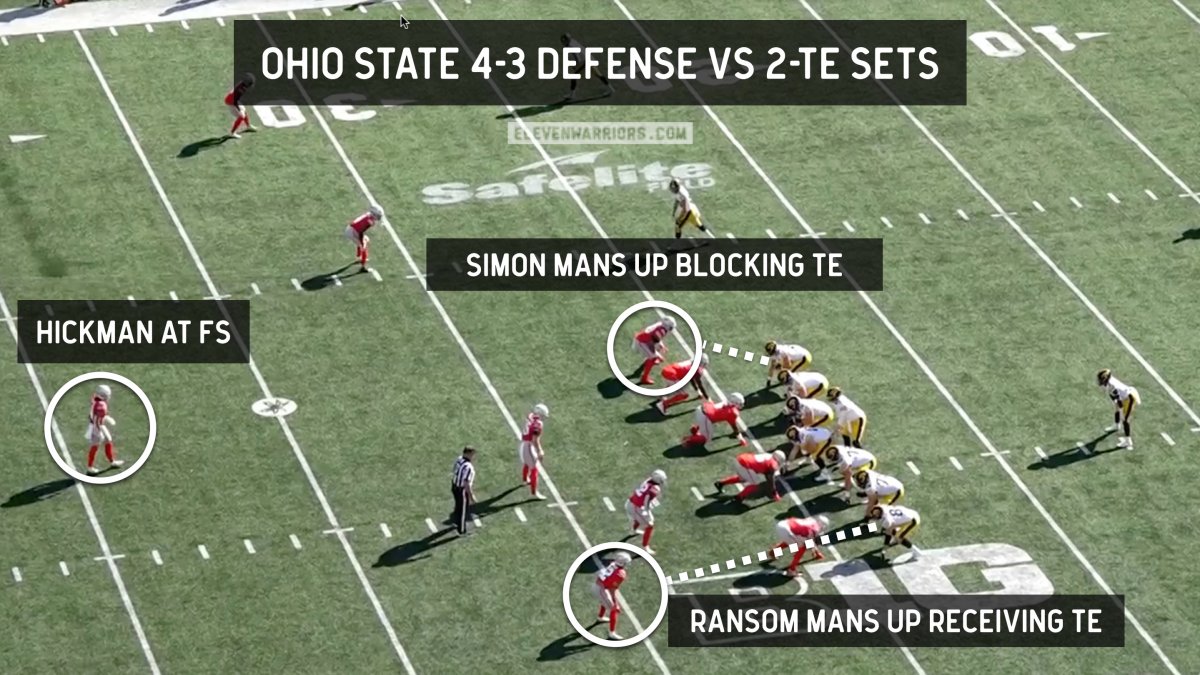
But such offenses often featured just one tight end capable of making plays through the air while the other was more of a glorified tackle. Luckily, the Buckeyes have already matched up against the only other team in America with tight ends who can be compared with Bowers or Washington.
In fact, it was Notre Dame's Michael Mayer who took home the Mackey Award this season, earning the title as the nation's best tight end. In the season opener, however, he managed to catch five passes but tallied only 32 yards receiving thanks to the efforts of Ohio State's most versatile defenders.
Since that game, the Buckeyes have often traded deep safety duties between Ronnie Hickman and Lathan Ransom, leaving McCalister to line up in the slot. Against ND and Mayer, however, the defense essentially broke into four parts: the 4-man line, 2 linebackers, 2 box safeties (Hickman and Ransom), and a 3-man secondary of McCalister and the cornerbacks.
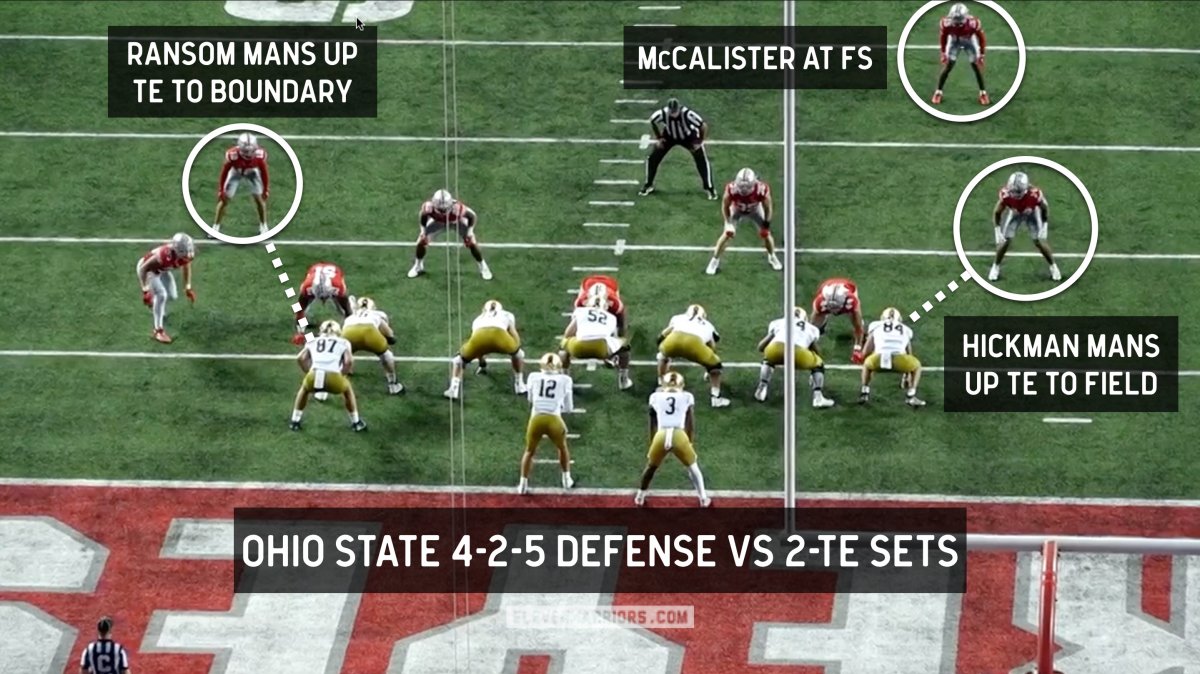
Hickman and Ransom effectively shadowed Mayer and fellow tight end Kevin Bauman all over the field that night in Ohio Stadium, allowing the front six to maintain their gap integrity against the run while keeping the star tight end from making plays in space.
Given that Bowers is effectively the Bulldogs' best slot receiver and McCalister shouldn't be needed to line up in the alley across from him, elements of the same plan that worked against the Irish should be replicable in the Peach Bowl when facing a similar threat from the tight end spot.
Lean on the Leo package
Against a Georgia offense that looks to gain an advantage through similar means of deception (using a variety of pre-snap shifts and motions), the Buckeyes can't simply line up and wait to react. One of Knowles' core philosophies is that he wants to dictate the action as much as the offense does.
While the way he moves his safeties around may be one such way he does so, the use of Jack Sawyer at the hybrid end/linebacker spot (Leo) is another. Sawyer likes to move around and show a variety of looks before settling into his designated spot for a given play, keeping the offense on its toes as he does so.
Not only does this help muck up run schemes, but it allows him to act as a spy against QBs that like to take off out of the pocket.
The Buckeyes employed more man-coverage than normal against Michigan and gave up a number of long touchdown passes as a result. Against a seasoned veteran like Stetson Bennett, attempting to man up all the time would be unwise, as he knows enough ways to beat it (including with his legs).
By moving Sawyer around to play games along the front, it will allow the Buckeye secondary to employ more zone coverages that may force Bennett to hesitate in passing situations, just as they have done to many other quarterbacks this season. Despite the poor performance in the fourth quarter against its biggest rival, the Ohio State defense remains one of the top 10 most efficient units in the country and relying on the schemes that got them there should be a winning formula in the CFP semifinal.
